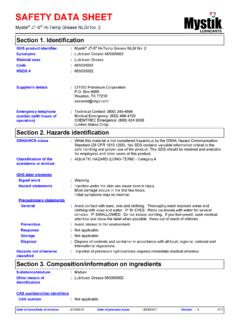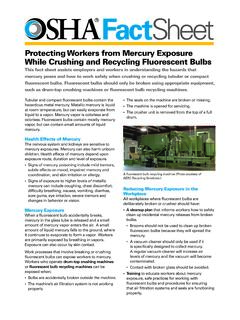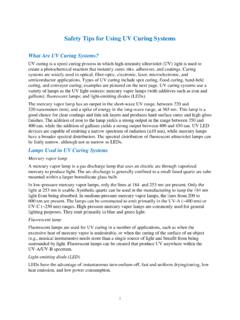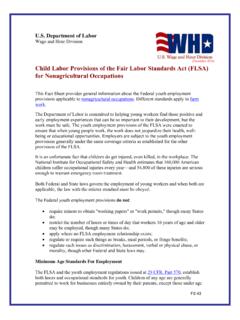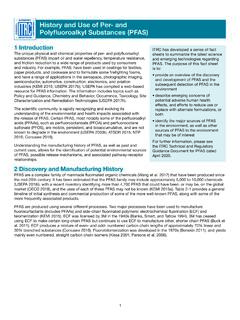Transcription of TAP FOOD SAFETY MANAGER REVIEW SHEET
1 TAP Series 1999-2021 Tap Series . All rights reserved. Tap Series and the Tap Series logo are registered trademarks of Tap Series. 1 TAP food SAFETY MANAGER REVIEW SHEET THIS IS FOR THE ANSI EXAM. REGULATIONS CAN VARY WITH YOUR LOCAL HEALTH DEPARTMENT. Keep and study while in the course and study again just before taking the examination. Lesson 1 Introduction Highly Susceptible Populations (HSPs) o The very young o The elderly o The chronically ill o Those with immune problems Five Most Common Risk Factors o Purchasing food from unsafe sources o Failing to cook food adequately o Holding food at improper temperatures o Using contaminated equipment o Practicing poor personal hygiene Agencies Regulating food And food Service o Department of Agriculture (USDA) Regulates meat, poultry, eggs, food crossing state boundaries or involves more than one state o food and Drug Administration (FDA)
2 Regulates all food other than meat, poultry and eggs. Publishes food Code o Center for Disease Control and Prevention (CDC) Conducts research into causes of illness and assists in investigations o Public Health Service (PHS) Conducts research into causes of illness and assists in investigations o State and Local Health jurisdictions Your Role As A MANAGER o Ensure SAFETY of customer o Ensure food is safe from the time it is delivered until food service o Ensure rules are in place and followed o Ensure staff knows their role o Be prepared for inspections Active Management Controls o Create a set of Standard Operating Procedures (SOPs)
3 O Ensure SOPs are followed o Train Staff o Evaluate and revise Lesson 2 Foodborne Illness Overview Foods Most Likely to Become Unsafe o Time and Temperature Controlled for SAFETY (TCS) - Milk, chicken, cooked rice, melons, sprouts, vacuum-packaged foods, eggs, meats, fish, and cooked potatoes o Ready-to-eat - Vegetables, fruits, deli, and bakery items TAP Series 1999-2021 Tap Series . All rights reserved. Tap Series and the Tap Series logo are registered trademarks of Tap Series. 2 Microorganisms are small living organisms that can only be seen through a microscope The Three food Contaminants o Biological (also known as Pathogens)
4 Bacteria, Viruses, Parasites, Fungi o Chemical Cleaners, sanitizers, poisons o Physical Glass, bandages, dirt, fake fingernails, jewelry FATTOM = food , Acidity, Temperature, Time, Oxygen, Moisture Consumer Advisory o Statements related to increased risk of eating raw or undercooked animal-derived foods o Must be on menus and/or menu boards, placards, table tents, or accessible & readable materials Lesson 3 - Foodborne Illnesses and Allergies Bacteria/Virus Characteristics food Most at Risk Prevention Shigella spp. Bacteria found in human feces Bacteria can remain in feces for weeks after symptoms have ended Illness occurs when eating or drinking contaminated food or water Transferred by flies Only small amount is needed for infection Those easily contaminated by hands Salads with TCS foods Foods washed in contaminated water Exclude food workers with diarrhea who have been diagnosed with illness caused by Shigella spp.
5 Use proper handwashing techniques Control flies Salmonella Typhi Bacteria found in blood and feces of humans infected with Typhoid Fever Bacteria can remain in feces for weeks after symptoms have ended Only a small amount is needed for infection Severity depends on health of infected individual Ready-to-eat foods Beverages Exclude food workers with diarrhea who have been diagnosed with illness caused by Salmonella Typhi Use proper handwashing techniques Cook foods to minimum internal temperatures Non-Typhoidal Salmonella (NTS) Bacteria carried by farm animals Only small amount is needed for illness Severity of symptoms is based on health of impacted person and amount ingested Poultry and eggs Meat Milk and dairy products Produce, such as tomatoes, peppers, and cantaloupes Cooking poultry and eggs to minimum internal temperatures Prevent cross-contamination between poultry and ready-to-eat foods Exclude food workers vomiting or with diarrhea who have been diagnosed with illness caused by Non-typhoidal Salmonella Shiga toxin- producing Escherichia coli (STEC), (E.)
6 Coli) Bacteria found in intestines of cattle Contamination happens during slaughter Ground beef (raw and undercooked) Contaminated produce Cook food , especially ground beef, to minimum internal temperatures Purchase produce from TAP Series 1999-2021 Tap Series . All rights reserved. Tap Series and the Tap Series logo are registered trademarks of Tap Series. 3 Also found in infected humans and contaminated water Only small amount is needed for infection Produces toxins in intestines which causes illness Unpasteurized fruit juice reputable sources Prevent cross- contamination Exclude food workers with diarrhea who has been diagnosed with disease caused by E.
7 Coli Bacteria/Virus Characteristics food Most at Risk Prevention Hepatitis A Virus found in humans Can contaminate water and food Transferred by contact with food or equipment Only small amount can cause illness Very infectious May not show up for weeks Ready-to-eat foods Shellfish Use proper handwashing techniques Avoid bare hand contact with ready-to-eat foods Purchase shellfish from reputable suppliers Exclude food workers diagnosed with Hepatitis A or who have had jaundice for seven days or less Normal cooking temperatures does not destroy the virus Norovirus Virus transferred when infected humans touch equipment or ready-to-eat foods with fingers contaminated with feces Linked to contaminated water Only small amount can cause illness Very contagious.
8 Can become contagious within a few hours Virus remains in feces for days after symptoms have ended Ready-to-eat foods Shellfish Use proper handwashing techniques Avoid bare hand contact with ready-to-eat foods Purchase shellfish from reputable suppliers Exclude food workers vomiting or with diarrhea diagnosed with Norovirus Characteristics Foods Most at Risk Prevention Biological Toxins Poison created by plants, animals, mushrooms, and bacteria Passed through food chain Cannot be destroyed by cooking or freezing No odor or taste Fish Shellfish Purchase fish and shellfish from reputable suppliers Control time and temperature when handling raw fish Sources Symptoms Foods Most at Risk Prevention Chemical Contamination Pesticides Cleaning Supplies Cookware such as pewter, copper, zinc, brass, cadmium, lead, or painted pottery Vomiting Diarrhea Ready-to-eat foods Acidic foods Use approved chemicals Keep chemicals in original containers Store chemicals away from food prep, store.
9 And service areas Follow manufacturer s directions Use appropriate kitchenware Physical Hair, fingernails, Cuts All types Watch for items that can spill into TAP Series 1999-2021 Tap Series . All rights reserved. Tap Series and the Tap Series logo are registered trademarks of Tap Series. 4 Contamination bandages Glass metal shavings, staples Fish bones Dirt Bits of packaging Dental damage Choking Bleeding Pain food Limit the wearing of jewelry Wear hair and beard nets Closely inspect food when receiving it from suppliers Reject broken or damaged packaging Take extra precautions when cleaning up broken glass and other broken packaging food Adulteration - food can be contaminated due to low quality ingredients, misbranding.
10 Or improper labeling Intentional Contamination - food can be contaminated by someone at any point in the food chain for dishonest reasons Steps For Reporting An Outbreak 1. Identify the food involved 2. Stop selling suspected food and isolate it from other foods 3. Collect information on the person making the complaint 4. Notify local regulatory authority 5. Gather information on food source, lot number, product date 6. Prevent suspected employees from handling food 7. Cooperate with health department authorities 8. Take steps to correct problem food Defense System o A - Assure o L - Look o E - Employees o R - Reports o T Threat Eight Most Common food Allergens (Big 8) o Milk o Eggs o Fin Fish o Shellfish o Peanuts o Tree nuts o Wheat o Soy Lesson 4 Personal Hygiene Good Basic Personal Hygiene Habits o Bathe daily with soap and water o Arrive to work clean o When possible, change into work clothes at the work location o Keep fingernails short, well-trimmed, and clean o Avoid fake fingernails o Do not use nail polish o Restrain hair o Avoid hair accessories o Remov

